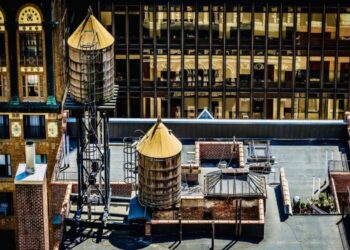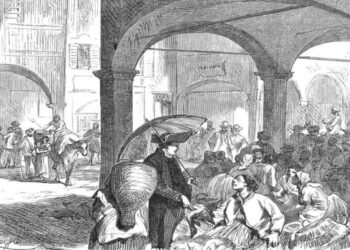This Monday witnessed a formidable wave of coordinated protests across the United States, with thousands of demonstrators calling for an immediate ceasefire in the ongoing conflict in Gaza. Activists converged on major urban centers, bringing with them a palpable sense of urgency and frustration over Israeli military actions and the U.S. government’s financial and political support for these operations. Critical infrastructures were targeted to maximize visibility and impact; among these were some of the nation’s most iconic landmarks.
In San Francisco, the Golden Gate Bridge, a symbol of architectural might and daily commuter traffic, was brought to a standstill as protesters draped banners with pro-Palestine messages and blocked both lanes, causing extensive traffic delays and drawing national media attention.
Similarly, in New York City, the area outside the New York Stock Exchange was flooded with nearly 300 protesters whose chants and banners disrupted the normal flow of finance professionals. It underscored the economic dimensions of the U.S. involvement in the Middle East. These strategic choices of protest locations reflect a deeply symbolic and highly strategic effort to call into question the ethical implications of U.S. foreign policy while directly affecting the operational routines of American infrastructure.
California Disruptions
In California, a significant demonstration unfolded as protesters seized the Golden Gate Bridge, effectively halting traffic in both directions. This audacious move was part of a broader national protest demanding a ceasefire in Gaza.
Demonstrators, bearing banners that read “Stop the world for Gaza” and “End the siege on Gaza now!” took a stand against what they perceived as unjust aggression. The protest not only disrupted thousands of commuters but also caught the attention of media and drew sharp criticism from several public figures who denounced the blockade as reckless and unlawful.
The California Highway Patrol (CHP) responded quickly, leading to the arrest of 26 individuals involved in the demonstration. The charges, ranging from unlawful assembly to obstruction of public thoroughfares, highlighted the legal boundaries crossed by the protesters.
This incident on the Golden Gate Bridge stands out as a stark example of how deeply the international conflict resonates within local communities and how it can spur significant domestic disruptions. While drawing public ire and legal action, such actions underscore the protesters’ desperation to spotlight their cause on a global stage.
New York’s Financial Heart Stalls
In the financial heart of New York City, the area around Wall Street came to a near standstill as approximately 300 protesters converged outside the New York Stock Exchange. This strategically chosen location served as a potent symbol of their protest against the economic support system behind U.S. military aid to Israel.
Chanting “Free, free Palestine!” and “Palestine will never die!”, the demonstrators voiced their dissent against what they see as a pivotal nexus of financial and political complicity in the conflict.
The use of watermelon balloons by the protesters was particularly symbolic, representing the color combination found in traditional Palestinian scarves and is recognized internationally as an emblem of Palestinian identity and resilience. This visual motif reinforced the message of solidarity and the call for liberation, resonating deeply as it floated above the heads of protesters amidst the backdrop of capitalism’s most iconic edifice.
The choice of this venue and the symbolic gestures employed by the protesters highlighted their intent to link the financial industry directly with the geopolitical issues at play, urging stakeholders and bystanders alike to reconsider where their allegiances and interests lie in the context of the Gaza conflict.
Response from Authorities and Officials
The protests, while largely peaceful, led to significant police action. In New York, law enforcement used flares to prevent protesters from advancing onto the Brooklyn Bridge, where several arrests were reportedly made, although specifics on charges were not immediately available.
Meanwhile, in Chicago, access to O’Hare Airport was temporarily blocked, leading to delays and 40 arrests. Senator Tom Cotton (R-Ark.) and other conservative voices have called for stern measures against the protesters, labeling the demonstrations as pro-Hamas and suggesting aggressive countermeasures by civilians.
The demonstrations have drawn polarized responses. Some commentators and politicians have condemned the protesters’ tactics as illegal and disruptive. For instance, Clay Travis expressed a desire for legislation imposing severe penalties on such demonstrations. Conversely, protest organizers and participants advocate for these bold actions as necessary to draw attention to what they see as a humanitarian crisis in Gaza, urging a halt to U.S. military aid to Israel.
Florida’s Strict Stance
In Florida, the reaction was particularly stringent. Bryan Griffin, speaking for Governor Ron DeSantis, emphasized that the state’s law enforcement would promptly arrest anyone obstructing traffic, reflecting a no-tolerance policy for roadway disruptions. This stance showcases the broader national debate over how to handle protests that intersect with critical infrastructure and civil order.
Philadelphia, Miami, and Tampa also saw significant gatherings calling for peace in Gaza. These protests, while unified in their message, varied in their execution and the local government’s response. In Philadelphia, a large crowd outside City Hall prompted a substantial police turnout, though no arrests were made. Miami and Tampa protesters emphasized the need for a ceasefire, reflecting widespread public frustration with the ongoing conflict.
These protests are part of a larger wave of global discontent with the Gaza situation. From the U.S. to Australia, activists coordinated through social media and other platforms to stage demonstrations that they hoped would leverage public attention and political pressure to change U.S. foreign policy and Israel’s military strategy.
The U.S. finds itself at a crossroads, with domestic unrest sparked by international conflict. As these protests disrupt daily life and prompt a gamut of responses from all levels of government, the core issues at hand reflect deep divisions about international relations, peace, and justice. With calls for a ceasefire growing louder, the world watches to see how one of the most powerful nations will navigate the complexities of diplomacy, civil rights, and global responsibility.
Coverage of these events has varied widely, with some outlets focusing on the legality and inconvenience of the protests, while others highlight the human rights issues at play. This bifurcation in the media landscape underscores the polarized nature of public discourse surrounding Israel, Palestine, and the United States’ role in the region.
As the U.S. grapples with these contentious issues, the calls for peace and policy change show no signs of abating. The nation remains a pivotal battleground for ideas and ideologies, not just on domestic issues, but also on the global stage, where the impacts of its policies are felt far and wide.







